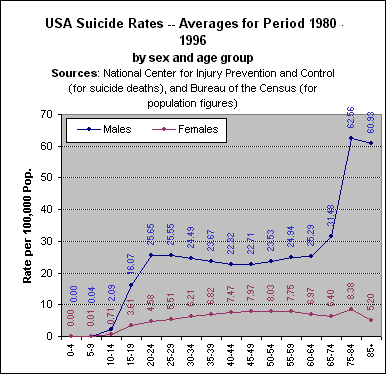
Suicide rates in the United States among our youth, ages 10-24, rose 8% in 2007 according to the Centers for Disease Control. Suicide rates for young males peak during their later teen and early adult years. The chart below clearly shows these patterns.

You will notice that suicide rates for males begin to rise between the ages of 15-19 and don’t level off until after age 24. (There is another peak later in life, but we are focusing on the earlier male suicides).
One area of research in suicide rates among young males is exploring the role that rites of passage rituals play in guiding our youth. A rite of passage ritual or coming of age ritual marks the movement from childhood to adulthood and has been very prominent in many cultures of the past but is being passed over as insignificant in modern times. These rituals clearly marked that liminal space between adolescence and manhood and with them came well understood expectations and clear guidance to young males (in this case) on the changes in their role within the community, expectations and visible measures of success within that transition. Examples of these rituals can still be seen today within some religious communities such as Catholic confirmations and Jewish Bar Mitzvahs. Though more symbolic than substantial, the continuation of these rituals could be part of the reason that suicide rates are lower in countries with higher religiosity rates (Pelham 2008).


Emile Durkheim concluded that “…suicide varies inversely with the degree of integration of the social groups of which the individual forms a part.” (Farganis 2008:64) The less connected to a social structure a person feels, the more susceptible to suicidal tendencies. It is difficult to feel connected to your society or individual culture if you have no way of knowing what is expected of you and how to achieve those things. How does a young man for example know when it is time to leave his childish ways behind him and begin to act like a man. I don’t think they are even sure what that is supposed to consist of since our society tends to be very vague on the requirements and expectations. Do they assume this manhood role when they graduate from High School? College? When they marry? Rites of Passage rituals clearly mark that transition and help to guide and educate our young men on the “next steps” in their journey.




Native Aboriginals in Australia are beginning to understand this theory of egoistic suicide when they look at the suicide rates in their native lands. Boys who have access to and still participate in Native rites of passage rituals show a marked decrease in suicide rates. For this reason, groups like “The Rediscovery Program” are reintroducing these ancient ways into modern times with great success (Yunkaport 2007).

Perhaps here in the United States, where we mark the transition into adulthood by the onset of legal drinking, smoking and gambling, we should reflect on our own varied cultural backgrounds and bring back some of the old traditions. We definitely need to look at ways to make our youth feel as though they belong and how they fit into our society and their own cultures.

Farganis, James. 2008. Readings in Social Theory, The Classic Tradition to Post Modernism. 5th ed. New York, New York:McGraw-Hill.
Lubell, K.M., S.R. Kegler, A.E. Crosby, D. Karch. 2007. “Suicide Treads Among Youths and Young Adults Ages 10-24 Years”,
Morbidity and Mortality Weekly Report. September 7, 2007 56:906-908. Retrieved September 3, 2007
(http://www.ihs.gov/MedicalPrograms/PortlandInjury/Worddocs/News/SuicideTrendsAmongYouthsCDC-Sept2007.pdf)
Pelham, Brett and Zsolt Nyiri. 2008. “In More Religious Countries, Lower Suicide Rates.” Gallup Poll July 3, 2008.
Retrieved September 4, 2008 (http://www.gallup.com/search/default.aspx)
Yunkaporta, Tyson. 2007. “Native Rites of Passage Today: Aboriginal Manhood Roles when Traditional Initiation is Gone.”
Australian-Indigenous-Peoples.suite 101December 18, 2007. Retrieved September 28, 2008 (http://australian-indiginous –
peoples.suite.101.com).